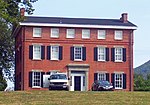Fishkill Creek

Fishkill Creek (also Fish Kill, from the Dutch vis kille, for "fish creek") is a tributary of the Hudson River in Dutchess County, New York, United States. At 33.5 miles (53.9 km) it is the second longest stream in the county, after Wappinger Creek. It rises in the town of Union Vale and flows generally southwest to a small estuary on the Hudson just south of Beacon. Part of its 193-square-mile (500 km2) watershed is in Putnam County to the south. Sprout Creek, the county's third-longest creek, is its most significant tributary. Whaley and Sylvan lakes and Beacon Reservoir, its largest, deepest and highest lakes, are among the bodies of water within the watershed. While the creek is not impounded for use in any local water supply, it remains a focus of regional conservation efforts as a recreational and aesthetic resource, especially since the lower Fishkill watershed has been extensively developed in the last two decades. It flows through several local parks and is a popular trout stream. Industries and mills along it helped spur the settlement of the region.
Excerpt from the Wikipedia article Fishkill Creek (License: CC BY-SA 3.0, Authors, Images).Fishkill Creek
Dennings Point Trail,
Geographical coordinates (GPS) Address Nearby Places Show on map
Geographical coordinates (GPS)
| Latitude | Longitude |
|---|---|
| N 41.481944444444 ° | E -73.985555555556 ° |
Address
Dennings Point Trail
Dennings Point Trail
12508
New York, United States
Open on Google Maps




